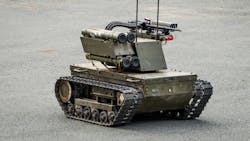Forecasts at market research firm Frost & Sullivan point to an estimated $481 billion in spending by the U.S. Department of Defense (DoD) between 2018 and 2024 on technology development for new weapons systems. The spending projections are part of Frost & Sullivan’s latest research, “US Defense Science and Technology Research Market, Forecast to 2024” (part of the firm’s Aerospace and Defense Growth Partnership Service program). The study offers an overview of the science and technology (S&T) research market focused on the U.S. Armed Forces and the types of opportunities for companies serving those markets.
Referring to the Department of Defense (DoD) budget for fiscal year 2021, John Hernandez, senior industry analyst at Frost & Sullivan, explains: “According to the most recent defense budget, combined spending on research, development, testing and evaluation (RDT&E) for over 1,100 programs by defense-wide organizations is estimated to reach $106.56 billion. This wide variety of projects provides opportunities for many commercial markets to collaborate with the DoD.”
As is typically the case, technological developments in military markets will eventually impact commercial markets as well, and developments in autonomous vehicles, artificial intelligence (AI) and robotics for military applications are expected to quickly make their way to the commercial sectors. “Most concepts being explored by the Armed Forces will have an impact in commercial market spaces as well,” noted Hernandez. “Companies working with the DoD on RDT&E development programs will have an advantage toward the development of parallel commercial solutions.”
Frost & Sullivan advises companies working across the commercial and military markets to remain open to commercial-off-the-shelf (COTS) solutions in hardware and software for military customers. At the same time, those companies must make strong investments in their own R&D efforts in order to develop unique and timely solutions. Some of the technologies needed for future defense systems include robotics, AI and machine learning, as well as secure battlefield communications systems, and these technologies will be needed in extremely integrated form to serve the warfighter.
About the Author
Jack Browne
Technical Contributor
Jack Browne, Technical Contributor, has worked in technical publishing for over 30 years. He managed the content and production of three technical journals while at the American Institute of Physics, including Medical Physics and the Journal of Vacuum Science & Technology. He has been a Publisher and Editor for Penton Media, started the firm’s Wireless Symposium & Exhibition trade show in 1993, and currently serves as Technical Contributor for that company's Microwaves & RF magazine. Browne, who holds a BS in Mathematics from City College of New York and BA degrees in English and Philosophy from Fordham University, is a member of the IEEE.
